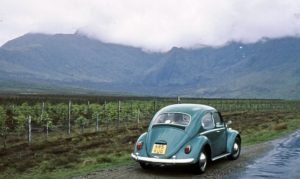Classic Volkswagen History
by: Sam Park

Gordon Hatton [CC BY-SA 2.0 (http://creativecommons.org/licenses/by-sa/2.0)], via Wikimedia Commons
Classic Volkswagen History
At the 1933 Berlin Auto Show, Adolf Hitler announced his plans of coming up with a small car, affordable by the average people in Germany. This statement was made with the intention of gaining the support of the people of Germany to his regime. Legend states that just before making the announcement to the world, Adolf Hitler approached Ferdinand Porsche (who was working as an auto consultant after offering his expertise to the leaders like Daimler-Benz and Auto Union) with his intention of a small car.
The car, according to the demands set by Adolf Hitler, had to be a four-seater that was capable of cruising at 62 mph for a 33 mpg besides being air-cooled. He called it as the “Volkswagen’, meaning the “people’s car.” The biggest challenge that Hitler placed before Porsche was his demand for the car to be priced below 1,000 Marks.
The speech at the Berlin Auto Show was followed by Hitler’s order for three prototypes of the new car within the next ten months. As Porsche, who had, in between designed a small car that more or less coincided with the demands set forth by Hitler, he concentrated his efforts in modifying these designs to meet the requirement.
In the year 1935, in the midst of his new blueprint, Porsche visited America to evaluate and learn on the assembly line production adopted by GM, Packard and Ford in manufacturing.
Later in 1936, Porsche submitted the three prototypes of the new car after putting it forward to a number of road tests to check for its stability and reliability. Erwin Komenda, the chief engineer of Porsche, was the one behind the design of the car, which is known as the “Beetle” today.
Later at the Auto exhibition of 1938 Hitler announced his decision to start with the production of the new car. It was at this juncture that he renamed the new car as ‘KdF Wagen’ or the ‘Kraft durch Freude’ meaning ‘strength through joy.’ Legend states that the Swastika surrounded by the cogged wheel was the first official emblem of KdF Wagen.
The new factory employed people with the expertise from America for the production of the new car. However, the production of the cars never realized with the factory directing its attention to the production of military vehicles during World War II. After the fall of the Germans, when the British Military Government took over the company, it started the production of the car from the blueprints discovered under the expert guidance of Major Ivan Hirst. It was during this period that the name was changed back to ‘Volkswagen’ and it launched the “Beetle.”
But attempts made by the British Government to relieve them of control of the company faced denial from the French Government, Ford Motor Company and Fiat. It was in 1949 that the government of the Federal Republic of Germany took over the trusteeship of Volkswagenwerk. After this phase, there has been no looking back for Volkswagen, which widened its horizons through the Volkswagen-Porsche partnership to become the world’s largest car manufacturer in terms of production.
| About The Author
McKennaAudi.com is a premier car dealership in Los Angeles. Check out
The author invites you to visit:
http://www.mckennavw.com |
Article Source:
http://www.articlecity.com/articles/auto_and_trucks/article_3261.shtml
